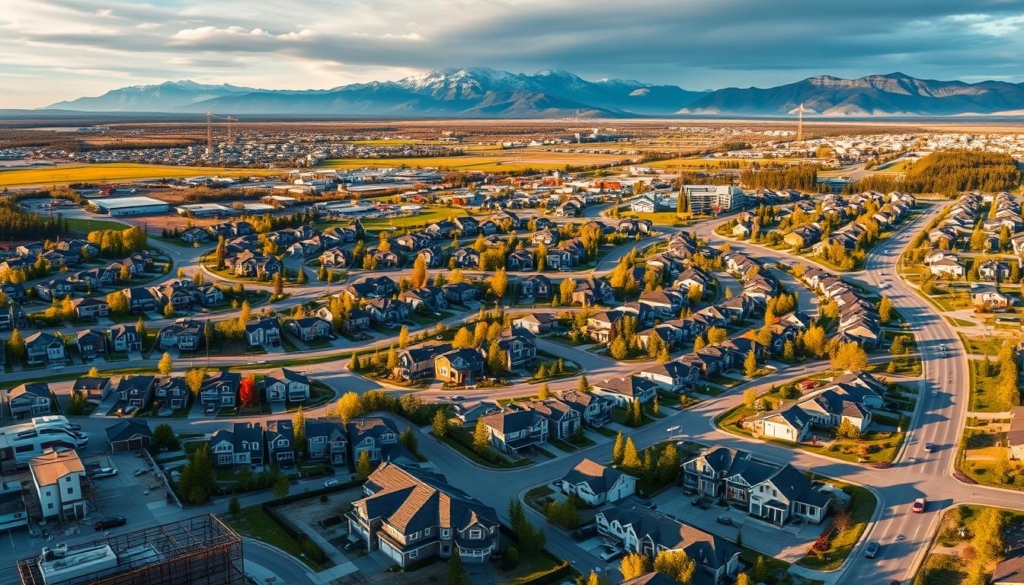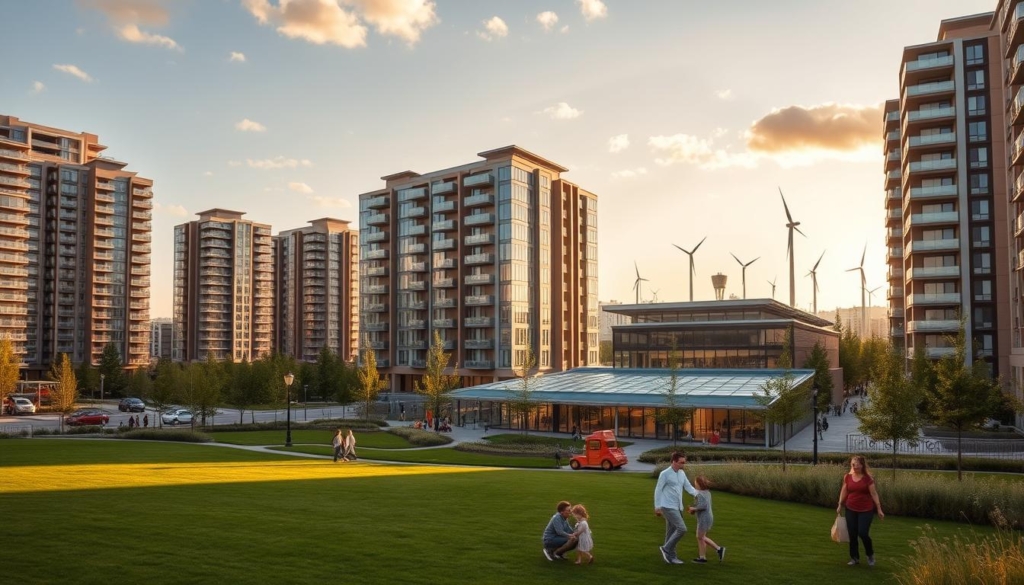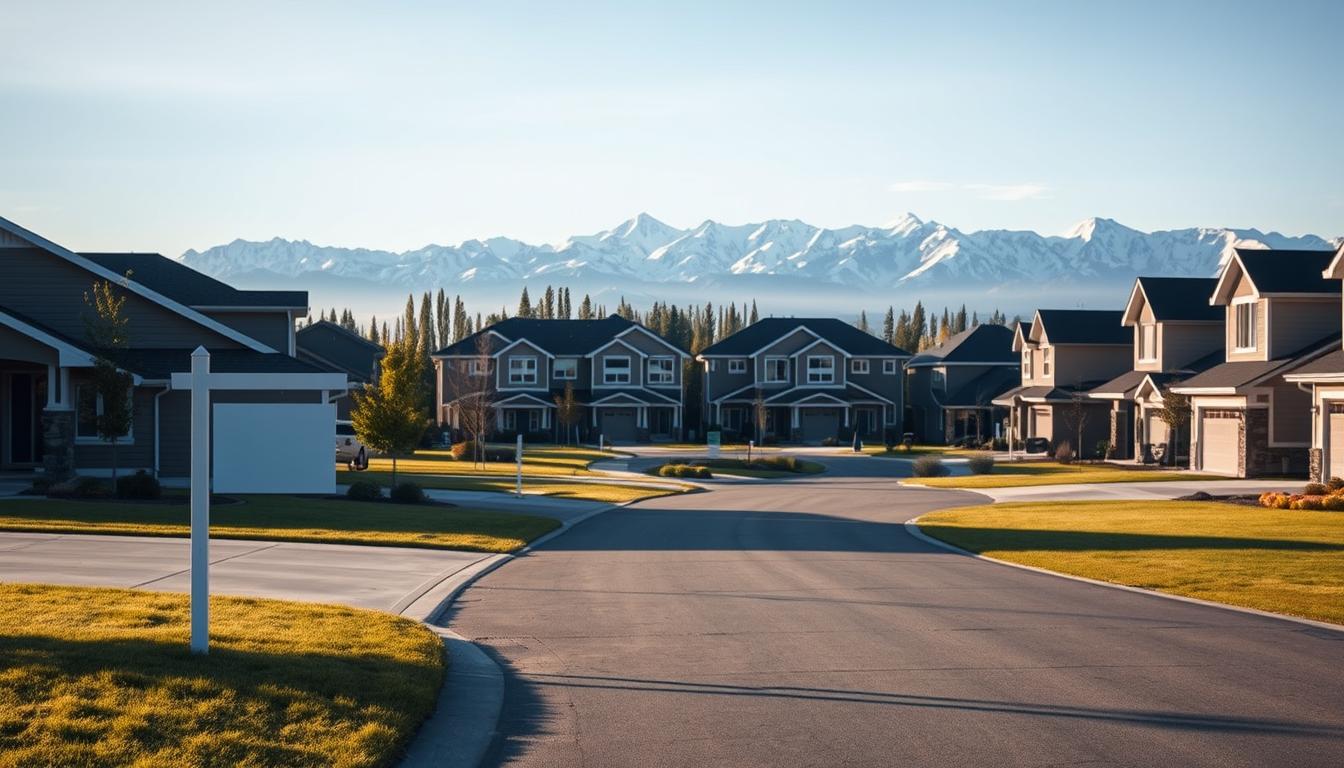As we look ahead to 2025, Alberta’s real estate market is poised for significant changes. Experts predict a rise in sales and steady price appreciation, driven by economic growth and population increases. This analysis is based on recent data from Canadian MLS® systems and insights from industry professionals.
New Homes Alberta, a trusted name in the industry, is here to guide you through these shifts. Whether you’re a first-time buyer or an investor, understanding the market trends is crucial. Factors like borrowing costs, regional variations, and economic drivers will play a key role in shaping the landscape.
This article will explore what to expect in 2025, including predicted changes in home prices, market stability, and emerging opportunities. For personalized advice, contact New Homes Alberta at (403) 305-9167. Stay informed and make confident decisions in this evolving market.
Key Takeaways
- Alberta’s real estate market is expected to see increased sales and price appreciation in 2025.
- Economic growth and population increases are key drivers of these trends.
- New Homes Alberta provides expert guidance for buyers and investors.
- Regional variations and borrowing costs will influence market dynamics.
- Stay informed to make confident decisions in a changing market.
Overview of Alberta’s 2025 Housing Market
Alberta’s real estate landscape is evolving, with new opportunities emerging for buyers and investors. The housing market is expected to see an 8.6% jump in transactions, driven by increasing demand and a robust sales-to-listings ratio. This growth is supported by key statistics, such as a projected 8% increase in average home prices and a steady rise in population.

For homebuyers, this means a chance to secure properties in a competitive yet rewarding market. First-time buyers can benefit from programs and incentives, while seasoned investors can explore high-return opportunities. Understanding metrics like active listings and average prices is crucial for making informed decisions.
“The current trends in Alberta’s housing market highlight a balance of demand and opportunity, making it an ideal time for both buyers and investors to act.”
New Homes Alberta is here to guide you through these changes. Whether you’re looking for your first home or expanding your investment portfolio, their expertise ensures you navigate the market with confidence. Stay tuned as we delve deeper into the economic drivers and regional trends shaping Alberta’s real estate future.
Economic Drivers Behind Alberta’s Real Estate Growth
Economic factors are playing a pivotal role in driving Alberta’s real estate growth. A diversified economy, job creation, and consumer confidence are key contributors. These elements not only support rising property values but also ensure market stability over time.

Impact of a Diversified Economy on Housing
Alberta’s economy is no longer solely reliant on oil and gas. Industries like technology, agriculture, and renewable energy are thriving. This diversification has created a steady stream of jobs, boosting demand for housing. For instance, employment growth in 2024 is forecasted at 2.9%, with a slight dip to 2.2% in 2025.
Such economic resilience ensures that the real estate market remains robust, even during global uncertainties. As industries expand, more people move to Alberta, increasing the need for homes. This trend is expected to continue, supporting long-term growth.
Indicators of Market Confidence and Sales Performance
Market confidence is reflected in key metrics like sales-to-listings ratios and year-over-year price changes. In 2024, home sales are projected to grow by 10%, with a similar increase expected in 2025. These numbers highlight a healthy balance between supply and demand.
Seasonal trends also play a role. For example, spring and summer typically see higher activity levels, while winter months are slower. Understanding these patterns helps buyers and investors make informed decisions.
“Alberta’s economic diversification and job growth are creating a stable foundation for real estate expansion. This ensures long-term opportunities for both buyers and investors.”
| Metric | 2024 | 2025 |
|---|---|---|
| Employment Growth | 2.9% | 2.2% |
| Home Sales Growth | 10.0% | 10.0% |
| Price Increase | 10.2% | 7.4% |
These economic drivers are shaping Alberta’s real estate market in meaningful ways. By understanding these factors, you can navigate the market with confidence and make informed decisions.
House Price Forecast Alberta 2025: What to Expect
The real estate landscape in Alberta is set to experience notable shifts as we approach 2025. Projections indicate varied growth across different property types, influenced by supply constraints and market demand. Understanding these trends can help buyers and investors make informed decisions.

Projected Increases Across Various Property Types
Detached homes are expected to see a steady rise in value, with a projected increase of 7.4% by 2025. Townhouses and condos are also anticipated to grow, though at slightly lower rates of 6.2% and 5.8%, respectively. These figures reflect the ongoing demand for diverse housing options.
Supply constraints are a key factor driving these changes. With inventory levels near 20-year lows, competition for available properties is intensifying. This scarcity is likely to push values higher, particularly in high-demand areas.
Comparisons with National Real Estate Trends
Alberta’s market stands out when compared to national averages. While the country as a whole expects a 4.7% increase in average home values, Alberta’s growth is projected to outpace this trend. This highlights the region’s unique market dynamics.
For example, the national median price for detached homes is forecasted at $855,900, while Alberta’s median is expected to reach $589,000. This difference underscores the affordability and investment potential in the province.
| Property Type | Alberta 2025 Forecast | National 2025 Forecast |
|---|---|---|
| Detached Homes | 7.4% | 6.0% |
| Townhouses | 6.2% | 5.5% |
| Condos | 5.8% | 5.0% |
These projections provide a clear picture of what to expect in Alberta’s real estate market. By staying informed, you can navigate these changes with confidence and seize emerging opportunities.
Regional Trends in Calgary and Edmonton
Calgary and Edmonton are experiencing distinct real estate trends, shaping opportunities for buyers and investors. While both cities are part of the same province, their markets are influenced by unique factors, leading to diverse outcomes. Understanding these regional differences is key to making informed decisions.

Calgary’s Residential Growth and Market Shifts
Calgary’s market is characterized by rapid residential growth and evolving dynamics. In January 2025, the city saw 1,451 home sales, reflecting a 12% yearly decline. Despite this, the average home price increased by 6.3% annually to $605,026.
Detached homes remain a popular choice, with average prices rising by 2.7% year-over-year to $780,000. Townhouses also saw growth, with prices increasing by 6% to $466,000. However, semi-detached homes experienced a slight decline of 0.1% in average price.
The sales-to-new listings ratio (SNLR) of 50% indicates a balanced market. Inventory levels surged by 69% year-over-year, providing more options for buyers. Neighborhoods like Beltline and Bridgeland are hotspots for growth, attracting both families and investors.
Edmonton’s Resilience and Emerging Opportunities
Edmonton’s market has shown remarkable resilience, with steady growth despite challenges. In January 2025, the average home price reached $438,278, marking a 9.9% yearly increase. Detached homes led the way, with prices rising by 16% year-over-year to $561,282.
Condos and townhouses also performed well, with annual increases of 5.2% and 16%, respectively. The city’s SNLR of 65% indicates a seller’s market, with high demand for available properties. Areas like Strathcona and Oliver are emerging as prime locations for buyers.
- Calgary’s balanced market offers opportunities for both buyers and sellers.
- Edmonton’s seller’s market highlights strong demand and growth potential.
- Neighborhoods in both cities are experiencing dynamic shifts, influencing investment strategies.
These regional variations underscore the importance of understanding local trends. Whether you’re exploring Calgary’s evolving neighborhoods or Edmonton’s resilient market, staying informed is crucial for success.
Immigration, Population Growth, and Employment Impact
The interplay of immigration, population shifts, and job creation is reshaping Alberta’s housing demand. These factors are driving changes in affordability and influencing the overall market dynamics. Understanding their impact is crucial for buyers and investors alike.

Shifts in Population Dynamics and Housing Demand
Immigration has been a major driver of Alberta’s population growth. In 2024, the province saw a 4.4% increase, with Calgary experiencing over 5% growth. However, federal immigration policy changes are expected to slow this trend in 2025, with a projected growth rate of just 1.9%.
This slowdown may ease pressure on rental markets, leading to higher vacancy rates. Yet, the existing population surge has already intensified housing demand. For example, an average of 2.5 people live in a household, increasing the need for larger properties.
Affordability remains a concern. In Calgary, homeownership costs account for 42% of median household income, while in Edmonton, it’s 34%. These figures highlight the challenges many face in securing affordable housing.
Job Growth and Its Influence on Home Prices
Employment growth is another critical factor shaping Alberta’s housing market. Sectors like construction, retail trade, healthcare, and education are driving job creation. Employment levels are expected to grow by 2% in 2025, supporting housing demand.
However, rising employment doesn’t always translate to affordability. As more people secure jobs, the competition for homes increases, pushing prices higher. This trend is particularly evident in urban centers like Calgary and Edmonton.
“The combination of job growth and population shifts is creating a dynamic housing market, with both opportunities and challenges for buyers and investors.”
Economic pressures also play a role. With consumer confidence improving, many are optimistic about the market’s future. Yet, 43% of Albertans remain concerned about their ability to repay debt, even with declining interest rates.
These factors—immigration, population growth, and employment—are shaping Alberta’s housing landscape. By understanding their interplay, you can make informed decisions in this evolving market.
Mortgage Rates and Financing Options in Alberta
Navigating the mortgage landscape in Alberta requires a clear understanding of current trends and future projections. Whether you’re a first-time buyer or an experienced investor, staying informed about financing options can help you make confident decisions.
Current Mortgage Trends and Future Predictions
As of early 2025, mortgage rates in Alberta range from 4.14% to 6.5%, with fixed and variable options available. Fixed-rate mortgages offer stability, while variable rates can provide savings if interest rates decline. Experts predict that rates will continue to fluctuate, influenced by economic conditions and Bank of Canada policies.
By December 2025, the 5-year fixed rate is expected to drop to 3.6%, making it an attractive option for buyers. Variable rates are projected to follow a similar downward trend, offering flexibility for those willing to take on some risk.
Financing Strategies for First-Time Homebuyers
First-time buyers can benefit from several financing strategies to ease their entry into the market. Programs like the First-Time Home Buyers’ Tax Credit provide a rebate of up to $1,500, reducing the financial burden. Additionally, the minimum down payment for properties under $500,000 is just 5%, making homeownership more accessible.
Here are some actionable tips for first-time buyers:
- Compare fixed and variable mortgage options to find the best fit for your financial goals.
- Take advantage of tax credits and incentives to reduce upfront costs.
- Work with a trusted lender to explore flexible payment plans and lower interest rates.
| Mortgage Type | Current Rate (2025) | Projected Rate (Dec 2025) |
|---|---|---|
| 5-Year Fixed | 3.94% | 3.6% |
| 5-Year Variable | 4.15% | 3.85% |
| 3-Year Fixed | 3.99% | 3.7% |
Understanding these trends and strategies can help you navigate the mortgage market with confidence. Whether you’re planning to buy your first home or refinance an existing property, staying informed is key to making the best financial decisions.
Real Estate Investment Opportunities in Alberta
Investors are finding Alberta’s real estate market ripe with opportunities in 2025. With steady growth in key areas and diverse property types, the region offers a promising landscape for those looking to maximize returns. Whether you’re a seasoned investor or just starting, understanding the market dynamics is essential.

Strategic Neighborhoods and High-Return Areas
Certain neighborhoods in Alberta are emerging as hotspots for high returns. In Calgary, areas like Beltline and Bridgeland are seeing significant growth, with detached homes averaging $796,753 and annual increases of 8.6%. Edmonton’s Strathcona and Oliver neighborhoods are also thriving, with detached homes priced at $580,234 and a yearly growth rate of 8.4%.
Market indicators like the sales-to-new listings ratio (SNLR) provide valuable insights. For example, Calgary’s SNLR of 50% indicates a balanced market, while Edmonton’s 65% leans toward a seller’s market. These metrics help investors identify areas with strong demand and growth potential.
Diversification Across Property Types for Investors
Diversifying your portfolio across different property types can mitigate risks and enhance returns. Detached homes remain a popular choice, but townhouses and condos are also gaining traction. In Calgary, townhouses average $448,425 with a 7.2% annual increase, while condos in Edmonton are priced at $287,995, growing by 7.6% yearly.
Rental properties are another lucrative option. Calgary’s rental yields are projected between 8-12%, making it an attractive market for income-focused investors. Edmonton’s affordability and steady growth also make it a viable choice for those looking to expand their portfolios.
“Diversification and strategic location selection are key to maximizing returns in Alberta’s real estate market. Investors who stay informed and adapt to market trends will find ample opportunities for growth.”
By focusing on high-demand neighborhoods and diversifying across property types, investors can navigate Alberta’s real estate market with confidence. Stay informed about market trends and leverage expert insights to make the most of your investments.
Government Initiatives and Housing Policies Supporting Growth
Government actions are playing a key role in shaping Alberta’s housing market. Recent policy changes and initiatives are designed to address affordability and increase supply. These efforts are creating a more balanced and accessible market for buyers and investors alike.

Affordable Housing Programs and Incentives
To tackle affordability challenges, the government has introduced several programs. For example, the First-Time Home Buyers’ Tax Credit offers a rebate of up to $1,500, reducing upfront costs. Additionally, changes to insured mortgage caps have made it easier for buyers to secure financing.
Affordable housing units are expected to increase by 15% by 2025, supported by funding initiatives. These programs aim to provide more options for low- and middle-income families, ensuring they can find suitable homes.
Regulatory Changes and Construction Initiatives
Regulatory updates are streamlining construction processes, encouraging new developments. For instance, housing starts in Alberta rose by 29.1% in July 2024 compared to the previous year. This activity is helping to address supply shortages and meet growing demand.
Construction incentives are also playing a part. Approximately 60% of new housing developments are supported by government funding. These initiatives are expected to boost the overall supply, making the market more competitive and accessible.
“Government policies are creating a foundation for sustainable growth in Alberta’s housing market. These efforts benefit both buyers and investors, ensuring long-term stability.”
By focusing on affordability and supply, these government actions are transforming the real estate landscape. Whether you’re a first-time buyer or an investor, these policies provide new opportunities to navigate the market with confidence.
Innovative Construction Trends and Green Building in Alberta
Alberta’s construction sector is embracing cutting-edge technologies to redefine development standards. From advanced building techniques to eco-friendly designs, the industry is evolving to meet the demands of a sustainable future. These trends are not only shaping the real estate market but also setting new benchmarks for efficiency and innovation.

Adoption of Advanced Technologies in New Development
Technologies like Building Information Modeling (BIM), drones, and artificial intelligence (AI) are revolutionizing the construction process. BIM, for instance, allows for precise planning and collaboration, reducing errors and saving time. Drones are being used for site inspections and progress tracking, while AI is optimizing project management and resource allocation.
These advancements are particularly evident in projects starting in january 2025. For example, the integration of AI in construction sites is expected to enhance safety and productivity, making it a game-changer for the industry.
Sustainability, Energy Efficiency, and Green Financing
The shift toward green building practices is gaining momentum in Alberta. Developers are increasingly focusing on energy-efficient designs and sustainable materials. Many projects are aiming for LEED certification or net-zero status, reflecting a commitment to environmental responsibility.
Green financing options are also becoming more accessible. Programs like the Canada Growth Fund are supporting sustainable construction initiatives, making it easier for developers to invest in eco-friendly projects. This trend is expected to continue, with significant growth in green building investments by 2025.
“Sustainability is no longer a choice but a necessity in modern construction. Alberta is leading the way with innovative practices and technologies.”
Government and private sector efforts are further driving this transformation. For instance, the $9 billion investment in affordable housing includes a focus on sustainable developments. These initiatives are not only addressing housing needs but also promoting environmental stewardship.
Examples of innovative projects include mixed-use developments in urban areas, which combine residential, commercial, and recreational spaces. These projects are designed to create community-centric living environments, aligning with consumer preferences for convenience and sustainability.
As Alberta’s construction industry continues to evolve, these trends are setting the stage for a more sustainable and efficient future. By adopting advanced technologies and green practices, the province is positioning itself as a leader in modern development.
Forecasting Alberta's Housing Outlook
Looking ahead, the real estate market in Alberta is shaped by a mix of economic, regional, and policy-driven factors. Key trends point to steady growth, with predicted increases in demand and value across property types. Economic drivers like job creation and population shifts continue to play a significant role in shaping opportunities.
Regional variations, particularly in Calgary and Edmonton, highlight diverse opportunities for buyers and investors. Government initiatives are also making strides in addressing affordability and boosting supply, ensuring a balanced market for the coming year.
For those considering a new home or investment, understanding these dynamics is essential. New Homes Alberta is here to provide expert guidance tailored to your needs. Contact us at (403) 305-9167 to explore your options and make informed decisions in this evolving market.





